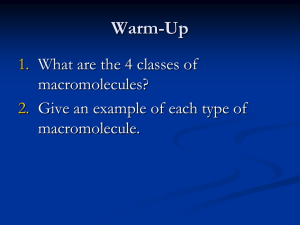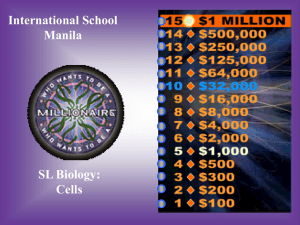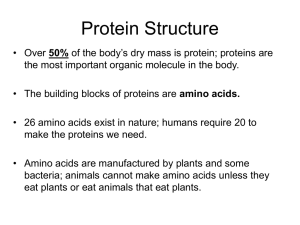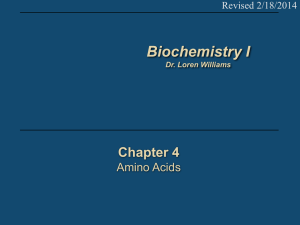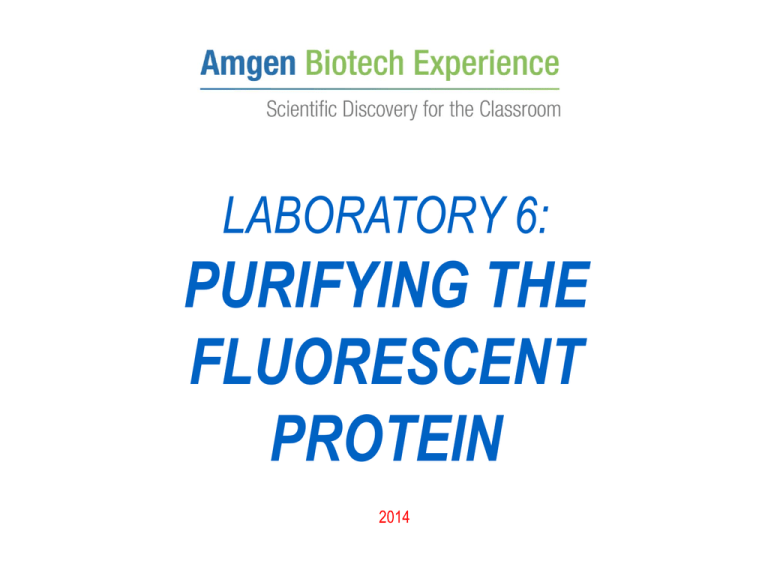
LABORATORY 6:
PURIFYING THE
FLUORESCENT
PROTEIN
2014
Overview
• In Laboratory 5, students incorporated
recombinant plasmid with rfp gene into a
living cell and confirmed that
transformation was successful
• In Laboratory 6, students will obtain cell
proteins and purify red fluorescent protein
from transformed cells grown in shaker
flask overnight
PART A: Lyse bacteria cells
Reasons for lysis
• Soluble proteins made by cell, including
red fluorescent protein, are dissolved in
cell cytoplasm
• Only way to access soluble proteins is to
lyse (break open) cell
• After lysis, soluble proteins can be easily
separated from insoluble structural
proteins
Procedure
• Obtain 1mL cell culture in tube
• Centrifuge for 5 min and identify location
of red fluorescent protein
• Remove supernatant with pipette
• Add another 1mL of cell culture to tube
and centrifuge for 5 min
• Remove supernatant with pipette
Procedure
• Tip tube and remove last bit of
supernatant with pipette, without touching
cell pellet
• Add elution buffer and drag closed tube
across tube rack to resuspend cells
• Add lysis buffer and incubate cells
overnight at room temperature to release
proteins from the cells
PART B: Separate RFP
Reasons for separation
• Although the bacteria make a lot of red
fluorescent protein, there are up to 1,000
other proteins in a living cell
• Those other proteins might interfere with
intended use of RFP or of any other
protein you are isolating
• Pharmaceutical companies require
purified protein
Procedure
• Centrifuge cells (be sure to balance),
and remove supernatant with RFP
• Add binding buffer to the supernatant
• Add supernatant to column and drain
• Add wash buffer to column and drain
• Add elution buffer to column and collect
RFP
Procedure
• Always add liquids to the side of column
• Never touch the resin with pipette
• Drain until 2 mm of liquid is left above
the column and never expose the resin
to air
• Wait until each solution has drained
before adding another solution
Separation uses protein folding
Unfolded
Folded−
hydrophobic
areas covered
Amino acids’ electric charge
• Proteins have hydrophobic and
hydrophilic amino acids
• Difference is electric charge distribution
• Hydrophobic amino acids ARE NOT
attracted to water molecules
• Hydrophilic proteins ARE attracted to
water molecules
Unfolded
Unfolded
Unfolded
Folded
Protein folding in binding buffer
SIDER: If a mutation
CONSc
IDE
hanges
R: If aan
mutation
amino
CONSIDE
ac
changes
id,
R: how
If a mutation
an
might
amino
this
cac
hanges
cid,
hange
how
an
affec
mig
am
in folding andprotein
proteinfolding
function?
and
protein
protein
folding
function?
and protein function?
!
fi c proteins areSeither
pecifi chydrophobic
proteins are
Spec
either
orifi
hydrophilic
c proteins
hydrophobic
,are either
or hydrophilic
hydrophobic
,
nding on the relative
depending
amount
on the
of depending
hydrophobic
relative amount
on
and
the
ofrelative
hydrophobic
amount
and
of hy
ophilic amino ac
hydrophilic
ids they contain.
aminohydrophilic
Hydrophobic
acids they camino
ontain.ac
Hydrophobic
ids they contain. Hy
eins and hydrophilic
proteins
proteins
and hydrophilic
can proteins
be separated
proteins
and hydrophilic
bycan be separated
proteinsby
can be
mn chromatography
column
. Incthis
hromatography
method,
column
a column
. In
chromatography
thisis
method, a.cIn
olumn
this method
is
Column
ed with small beads
packed
that
with
aresmall
coated
pac
beads
with
kedthat
with
a material
are
small
coated
beads
with
that
a material
are coated
Resin-coat
sin) that attracts
(ahydrophobic
resin) that attrac
amino
(a
tsres
hydrophobic
ac
in)
idsthat
, andattrac
the
amino
ts hydrophobic
acids, and the
amino
beads
ure of proteinsmixture
is dissolved
of proteins
and pas
mixture
s
is
ed
dis
over
solved
ofthe
proteins
and pas
issdis
ed s
over
olved
the
and pass
s. In order for the
beads
hydrophobic
. In order for
amino
beads
the hydrophobic
ac
. In
ids
order
to stic
for
k amino
the hydrophobic
acids to sticami
k
e resin, the proteins
to themus
resin,
t be
the
unfolded
proteins
to theto
res
mus
expos
in,
t the
be
eunfolded
the
proteins mus
to expos
t be unfold
e the
ophobic aminohydrophobic
acids, which tend
amino
hydrophobic
toac
be
ids
found
, whicon
h
amino
tend
the to
acids
be,found
which on
tend
the
to
e of the protein.
ins
C
ide
ertain
of the
saltprotein.
solutions
inside
Certain
called
of the
s
buffers
alt
protein.
solutions
Certain
called
salt
buffers
solutio
nfold proteinswill
to varying
unfold degrees
proteins
will
. tounfold
varying
proteins
degrees
to
. varying degrees.
• In binding buffer,
hydrophobic proteins
unfold
!
!
• Unfolded hydrophobic
proteins adhere to the
hydrophobic column resin
• Folded hydrophilic
ER 6 | STUDENT
GUIDE
CHAPTER 6 | STUDENT GUIDE
E–6 proteins
never adhere to
the column
es
Amgen
erved.Foundation. All
© 2013
rights
Amgen
reserved.
Foundation. All rights reserved.
Hydrophilic
proteins
!
Unfolded
Unfolded
Unfolded
Folded
Protein folding in wash buffer
SIDER: If a mutation
CONSc
IDE
hanges
R: If aan
mutation
amino
CONSIDE
ac
changes
id,
R: how
If a mutation
an
might
amino
this
cac
hanges
cid,
hange
how
an
affec
mig
am
ein folding andprotein
proteinfolding
function?
and
protein
protein
folding
function?
and protein function?
!
fi c proteins areSeither
pecifi chydrophobic
proteins are
Spec
either
orifi
hydrophilic
c proteins
hydrophobic
,are either
or hydrophilic
hydrophobic
,
nding on the relative
depending
amount
on the
of depending
hydrophobic
relative amount
on
and
the
ofrelative
hydrophobic
amount
and
of hy
ophilic amino ac
hydrophilic
ids they contain.
aminohydrophilic
Hydrophobic
acids they camino
ontain.ac
Hydrophobic
ids they contain. Hy
eins and hydrophilic
proteins
proteins
and hydrophilic
can proteins
be separated
proteins
and hydrophilic
bycan be separated
proteinsby
can be
mn chromatography
column
. Incthis
hromatography
method,
column
a column
. In
chromatography
thisis
method, a.cIn
olumn
this method
is
Column
ed with small beads
packed
that
with
aresmall
coated
pac
beads
with
kedthat
with
a material
are
small
coated
beads
with
that
a material
are coated
Resin-coat
sin) that attracts
(ahydrophobic
resin) that attrac
amino
(a
tsres
hydrophobic
ac
in)
idsthat
, andattrac
the
amino
ts hydrophobic
acids, and the
amino
beads
ure of proteinsmixture
is dissolved
of proteins
and pas
mixture
s
is
ed
dis
over
solved
ofthe
proteins
and pas
issdis
ed s
over
olved
the
and pass
s. In order for the
beads
hydrophobic
. In order for
amino
beads
the hydrophobic
ac
. In
ids
order
to stic
for
k amino
the hydrophobic
acids to sticami
k
e resin, the proteins
to themus
resin,
t be
the
unfolded
proteins
to theto
res
mus
expos
in,
t the
be
eunfolded
the
proteins mus
to expos
t be unfold
e the
ophobic aminohydrophobic
acids, which tend
amino
hydrophobic
toac
be
ids
found
, whicon
h
amino
tend
the to
acids
be,found
which on
tend
the
to
e of the protein.
ins
C
ide
ertain
of the
saltprotein.
solutions
inside
Certain
called
of the
s
buffers
alt
protein.
solutions
Certain
called
salt
buffers
solutio
nfold proteinswill
to varying
unfold degrees
proteins
will
. tounfold
varying
proteins
degrees
to
. varying degrees.
• In wash buffer, moderately
hydrophobic proteins fold
!
!
• Highly hydrophobic
proteins, including RFP,
stay unfolded
• Folded moderately
hydrophobic proteins are
ER 6 | STUDENT
GUIDE
CHAPTER 6 | STUDENT
fromGUIDE
the column
E–6 released
es
Amgen
erved.Foundation. All
© 2013
rights
Amgen
reserved.
Foundation. All rights reserved.
Moderately
hydrophobic
proteins
!
ed
Unfolded
Folded
Folded
Folded
Protein folding in elution buffer
c
E
hanges
id,
R: how
If a mutation
an
might
amino
this
cac
hanges
c
id,
hange
how
an
affec
might
amino
t this
acid,
change
how might
affect this change affect
folding
n function?
and protein function?
!
!
!
drophilic
proteins
hydrophobic
,are either
or hydrophilic
hydrophobic
,
or hydrophilic,
ng
obic
amount
on
and
the
ofrelative
hydrophobic
amount
and
of hydrophobic and
hobic
ey
iliccamino
ontain.ac
Hids
ydrophobic
they contain. Hydrophobic
roteins
ated
and hydrophilic
bycan be separated
proteinsby
can be separated by
c
n
umn
hromatography
thisis
method, a.cIn
olumn
this method,
is
a column is
Column
Column
hat
with
a material
are
small
coated
beads
with
that
a material
are coated with a material
Resin-coated
Resin-coated
ophobic
sthat
, andattrac
the
amino
ts hydrophobic
acids, and the
amino acids, and the
beads
beads
olved
er
ofthe
proteins
and pas
issdis
ed s
over
olved
the
and passed over the
drophobic
n
ds
order
to stic
for
k amino
the hydrophobic
acids to sticamino
k
acids to stick
mus
es
expos
in,
t the
be
eunfolded
the
proteins mus
to expos
t be unfolded
e the
to expose the
whic
und
obicon
h
amino
tend
the to
acids
be,found
which on
tend
the
to be found on the
ain
ed
the
s
buffers
alt
protein.
solutions
Certain
called
salt
buffers
solutions called buffers
old
ying
proteins
degrees
to
. varying degrees.
ved.
• In elution buffer, highly
hydrophobic proteins,
including RFP, fold
!
!
!
• Folded highly
hydrophobic proteins,
including RFP, are
released from the
column
• RFP can be collected
RFP
Column
Resin-coated
beads
Results



